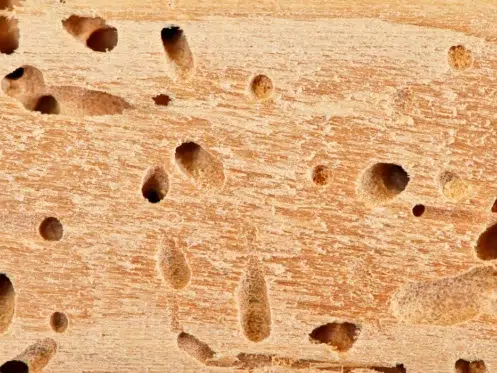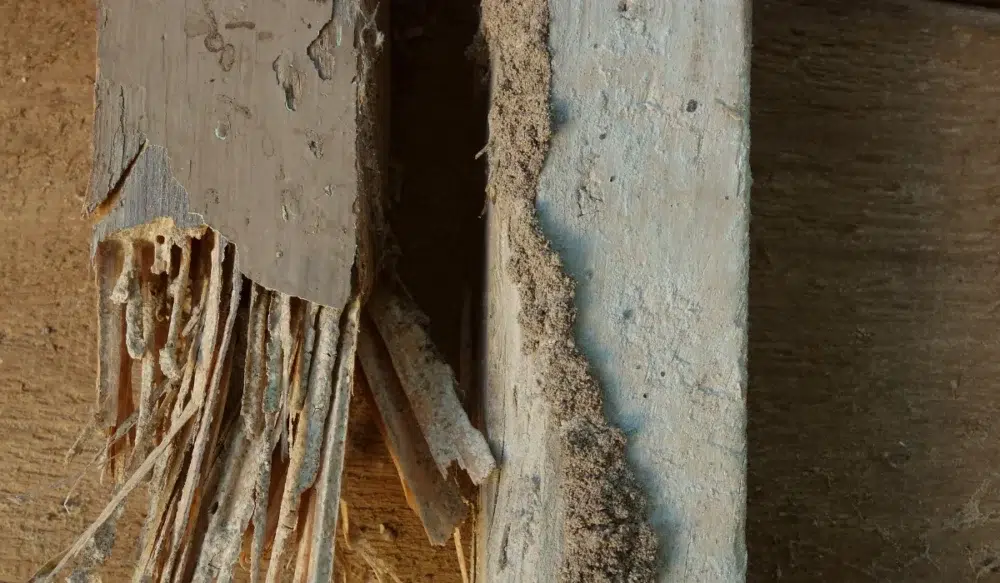Finding termites in your home is stressful, but you can catch the signs early. These small pests can hide and damage wood before you notice them. Knowing the early signs of termites in Gilbert, AZ, helps you act fast and save on repairs.
In Gilbert and nearby Chandler and Mesa, warm weather and heavy irrigation boost termite activity. Most Arizona termites hide in walls or soil, so you need to look closely to spot them early.
Whether you’re new to the area or a longtime homeowner, understanding what termite warning signs look like and when to call for professional termite control in Gilbert, AZ, can make all the difference.
Key Takeaways
- Watch for mud tubes, hollow-sounding wood, and discarded wings as typical signs of termite activity.
- Subterranean termites are the most common species in Gilbert and can cause extensive damage that stays out of sight.
- Regular termite inspections are crucial for detecting infestations early and safeguarding your investment.
- Professional termite control from Green Home Pest Control ensures safe, effective, and lasting protection.
Common Signs of Termites in Gilbert Homes
Spotting early signs of termites in Gilbert, AZ, can prevent thousands in repairs. These destructive pests work quietly in walls, floors, and foundations. Look for:
- Mud tubes: Pencil-thin tunnels made of soil and moisture. These help termites travel between the nest and wood.
- Hollow-sounding wood: Tap baseboards, door frames, or floors. If it sounds hollow, feels soft, or shows signs of damaged wood, termites may be inside.
- Frass (termite droppings): Small pellet-like droppings near wood, often linked to drywood termites.
- Wood risk factors: Homes with wood framing or nearby wooden structures and woodpiles face a higher risk in Gilbert’s warm, moist soils.
Understanding Termite Activity in Arizona
Termite activity tends to increase during the spring and monsoon seasons, when humidity levels rise. In Arizona, the most common species are subterranean termites, which live underground and feed on cellulose, a component found in wood and paper.
These termites rely on moisture and nearby wood as their primary food source, making irrigated lawns and drip systems perfect for them.
Watch for bubbling paint or sagging floors as termites eat the wood below. Over time, this weakens your home’s structure. Seeing winged termites, or termite swarmers, inside or outside is a significant warning sign that new colonies could be forming nearby.
When termites swarm on warm, humid evenings, look for shed wings near lights, doors, and windows.
The Difference Between Subterranean and Drywood Termites
In Gilbert, most termite problems come from subterranean termites in Arizona, but drywood termites are also a concern. Subterranean species live in the soil and use mud tubes to reach your home’s foundation. They often enter through cracks or through plumbing penetrations in concrete slabs.
Drywood termites live entirely within the wood they infest. They don’t need soil contact or mud tubes, making them harder to detect. Instead, you might find termite droppings or frass near infested furniture or attic beams.
Both types of termites can cause significant damage, but subterranean termites are more common in Gilbert and require immediate termite treatment once identified.
Why Termite Inspections Matter for Gilbert Homeowners
Regular termite inspections are among the best preventative measures for early detection. A licensed professional checks for early signs and helps you avoid costly repairs.
During an inspection, our team checks the foundation, crawl spaces, baseboards, and attic for hidden wood damage. We also look for moisture and nearby wood structures or mulch that can draw termites.
In Phoenix, Scottsdale, and Queen Creek, year-round pressure makes regular inspections a smart idea.
Professional Termite Control and Treatment Options
Once an active termite infestation is confirmed, a professional termite control company will develop a customized treatment plan based on your property’s needs. Standard methods include bait stations or bait systems that target the termite colony directly.
Professionals may apply liquid termite treatments to create a protective barrier around your foundation. These treatments stop termites from entering and remove any already inside. For long-term protection, a trusted pest control service can provide a maintenance plan that offers continuous monitoring and quick action if termite activity returns.
If you’re wondering how much termite treatment costs in Gilbert, AZ, pricing depends on your property’s size, level of infestation, and treatment type. We provide transparent pricing and free estimates for all termite control services.
How Green Home Pest Control Protects Gilbert Homes
At Green Home Pest Control, we provide termite control in Gilbert, AZ that is safe for families and pets. We use eco-friendly methods that are effective against subterranean termites and other local pests.
We inspect and find where termites are active. Then we apply eco-friendly treatments to remove colonies and help stop future activity. We also provide ongoing monitoring to help keep your home termite-free year-round.
If you live in Gilbert, Chandler, Queen Creek, or Mesa, our team can help protect your home from termite damage.
Making the Right Termite Control Choice for Your Gilbert Home
Termites can cause severe damage if ignored, but quick action and solid information help protect your home. At Green Home Pest Control, we offer reliable termite inspections and treatments for Gilbert homeowners seeking safe, lasting results.
If you’ve seen signs of termite activity or want to stay ahead of problems, reach out for expert help.
Contact us today to schedule your termite inspection and protect your home.
FAQs
What are the first signs of termites in Gilbert homes?
Look for mud tubes, discarded wings, bubbling paint, or wood that sounds hollow when tapped. These are common signs of a termite infestation.
How often should I get a termite inspection in Gilbert, AZ?
Experts recommend scheduling regular termite inspections at least once a year, especially in areas such as Gilbert, Chandler, and Phoenix, where subterranean termites are prevalent.
What is the best termite treatment for Arizona homes?
A combination of bait systems and liquid termite treatments offers adequate, long-term protection. A licensed professional pest control company can determine which method best fits your situation.




